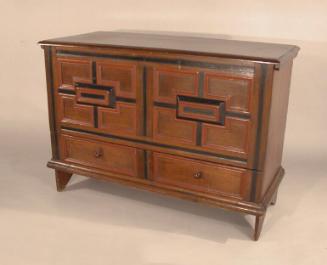Chest with Drawer
Furniture MakerMade by
Unknown
Date1670-1710
MediumTulip poplar primary wood, unidentified secondary wood, iron hardware
DimensionsPrimary Dimensions (overall height x width x depth): 30 1/2 x 44 5/8 x 20 1/2in. (77.5 x 113.3 x 52.1cm)
ClassificationsFurniture
Credit LineBequest of George Dudley Seymour
Object number1945.1.1133
DescriptionTulip poplar chest with drawer in the seventeenth century style. The arrangement of the chest with drawer consists of a chest that is 16 5/8 inches deep over one full-width drawer. The top has ovolo, or thumnail, molding on the front and sides; a cleat, or strip of wood extends from the front to back on the underside of each side of the top. The front of the chest has a top rail with a ban of plain, horizontal, incised molding, painted black. Below this, the front of the chest has two square, recessed panels, separated by a verntical stile, decorated with two vertical bands of incised molding, painted black. Each panel is decorated with a geometric pattern of applied wood and molding. In the center is a raised, square block, painted black and with canted edges; the center of the block is outlined in molding. Each side of the raised square is next to a rectangle, of the same width, outlined in molding. Each corner of each panel has a recessed, square corner block, also painted black. Below the two recessed panels is a horizontal rail,with a band of plain, horizontal, incised molding, painted black. Below this is a drawer, with two rectangular areas surrounded by molding, with a wood knob in the center of each rectangle. The two rectangles are separated by a short vertical stile, with two bands of vertical, incised molding, painted black. This arrangement gives the full-width drawer the illusion of being two smaller drawers. The front of the chest and drawer are flanked by vertical stiles that extend from the top down and form the front sides of the drawer; these are decorated with a band of vertical, incised molding, painted black. Base molding is located at the bottom of the drawer; this extends around to the sides of the chest with drawer. The sides of the chest extend down to form the side skirts and feet. Each side skirt consists of an inverted 'V'; the feet are straight at the corners. Hardware includes a pair of iron cotter-pin hinges at the back edge of the lid. The horizontal rail at the top of the chest has a keyhole in the center with a locking mechanism on the reverse side (now missing).
Condition: The drawer has been replaced, using 1981.92.0 as a model. Some moldings have been replaced. The cleats are replaced. The applied decoration has been repainted. The hardware is replaced.
Design and Construction Details:
Case Construction. The applied decoration on the chest imitates panel-and-frame construction, however, this is a six-board chest. The sides fit into rabbets in the front and back of the chest with drawer. The backboard is horizontally oriented and nailed at the edges. The bottom of the chest consists of a single board that is oriented side to side. It is nailed into a rabbet in the bottom edge of the front of the chest and fits into a groove at the lower edge of the backboard. The front of the chest is constructed from a single board that is decorated with applied wood and molding. There is no bottom beneath the drawer. Each case side extends down to form a side skirt and feet. The base molding is nailed to the case sides, just above the skirt.
Drawer Construction.
The drawer overlaps the side of the chest. The drawer runners are nailed to the sides of the case. The drawer front is made of a single board with applied wood, molding, and base molding. The base molding on the front of the drawer wraps around to the sides. The front edge of the drawer sides are nailed into a lap joint; the back edge of the drawer sides have a lap joint and are nailed to the back of the drawer. The thick bottom boards run side to side, are joined with a double rabbet, and are nailed to the bottom of the drawer sides, back and front.
Condition: The drawer has been replaced, using 1981.92.0 as a model. Some moldings have been replaced. The cleats are replaced. The applied decoration has been repainted. The hardware is replaced.
Design and Construction Details:
Case Construction. The applied decoration on the chest imitates panel-and-frame construction, however, this is a six-board chest. The sides fit into rabbets in the front and back of the chest with drawer. The backboard is horizontally oriented and nailed at the edges. The bottom of the chest consists of a single board that is oriented side to side. It is nailed into a rabbet in the bottom edge of the front of the chest and fits into a groove at the lower edge of the backboard. The front of the chest is constructed from a single board that is decorated with applied wood and molding. There is no bottom beneath the drawer. Each case side extends down to form a side skirt and feet. The base molding is nailed to the case sides, just above the skirt.
Drawer Construction.
The drawer overlaps the side of the chest. The drawer runners are nailed to the sides of the case. The drawer front is made of a single board with applied wood, molding, and base molding. The base molding on the front of the drawer wraps around to the sides. The front edge of the drawer sides are nailed into a lap joint; the back edge of the drawer sides have a lap joint and are nailed to the back of the drawer. The thick bottom boards run side to side, are joined with a double rabbet, and are nailed to the bottom of the drawer sides, back and front.
Status
Not on view










